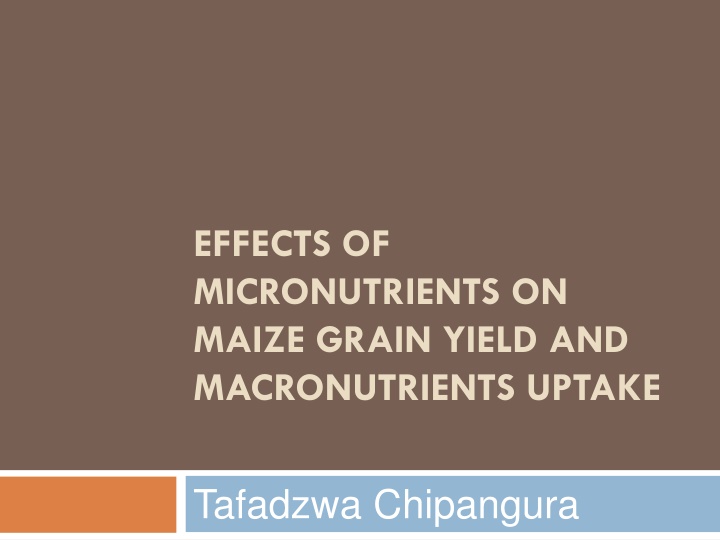
Impact of Micronutrients on Maize Grain Yield and Macronutrient Uptake
Explore the effects of micronutrients like Zinc, Iron, and Copper on maize grain yield and macronutrient uptake in this study by Tafadzwa Chipangura. Understand the importance of balanced crop nutrition, the role of micronutrients in plant growth, and how additional micronutrient supply can enhance crop productivity. Follow the experimental approach, specific objectives, and preliminary results to gain insights into maximizing maize yield through micronutrient management practices.
Download Presentation

Please find below an Image/Link to download the presentation.
The content on the website is provided AS IS for your information and personal use only. It may not be sold, licensed, or shared on other websites without obtaining consent from the author. If you encounter any issues during the download, it is possible that the publisher has removed the file from their server.
You are allowed to download the files provided on this website for personal or commercial use, subject to the condition that they are used lawfully. All files are the property of their respective owners.
The content on the website is provided AS IS for your information and personal use only. It may not be sold, licensed, or shared on other websites without obtaining consent from the author.
E N D
Presentation Transcript
EFFECTS OF MICRONUTRIENTS ON MAIZE GRAIN YIELD AND MACRONUTRIENTS UPTAKE Tafadzwa Chipangura
Introduction and Justification Micronutrients are essential for plant growth and play an important role in balanced crop nutrition. They promote the strong ,steady growth of crops that produce higher yields and increase harvest quality- maximizing a plant s genetic potential. Most micronutrients are immobile in soils and plants. There is therefore need to supply additional micronutrients to the soil.
Main Objective To determine the additional effects of micronutrients on maize grain yield and macronutrients uptake.
Specific Objectives 1. To determine the effect of adding Cu,Fe, Zn micronutrients on maize grain yield. 2. To determine the effect of adding Cu,Fe, Zn micronutrients on N, P,K,Ca and Mg uptake.
Approach Soils were sampled and characterised before the start of the experiment Treatments consisted of plots measuring 1m*1.5m laid out in a CRBD with treatments replicated 3 times. Soil pH was 5.9 Compound D was applied at a rate of 400kgs/ha. All treatments except control were top dressed with AN(split application at 4 and 6 weeks) at a rate of 300kgs/ha. Foliar application of micronutrients Zinc, Iron and Copper were applied at a rate of 5kgs/ha.
Approach Cont The following treatments were used: (i) Control (ii) Cpd D (iii) Cpd D + Zn +Cu (iv) Cpd D + Zn + Fe (v) Cpd D + Cu + Fe (vi) Cpd D + Zn +Cu+ Fe
Approach Cont Maize grain yield was determined at 12.5% moisture content and analysed for N,P, K, Ca,Mg, Zn, Fe, B & Cu. These will be evaluated against FAO/WHO standards for maximum permissible limits in maize grain.
Preliminary results for 2017/2018 season (1st Year) Table 1: Average maize grain yield for 2017/2018 Season Treatment 1(Control) Grain yield(T/ha) 3.2 2(Cpd D) 4.60 3(Cpd D +Zn+Cu) 5.00 4(Cpd D+Zn+Fe) 5.33 5(Cpd D+Cu+Fe 6.07 6(Cpd D+Zn+Cu+Fe) 6.13
Preliminary results Cont Fig 1:Average maize grain yield for 2017/2018 season 7 6 5 Grain yield (T/Ha) 4 3 2 1 0 Control Cpd D Cpd D +Zn+Cu Cpd D +Zn +Fe Cpd D +Cu+Fe Cpd D +Zn+Cu+Fe Treatment
Maize grain analytical results Table 3: Maize grain quality analytical results 2017/2018 Treatmen t N (%) Analytical Results P (%) Ca (%) K (%) Mg (%) Fe (ppm) Mn (ppm) Zn (ppm) B (ppm) Cu (ppm) 1(Control ) 0.17 0.14 0.15 1.9 0.16 35.5 23.4 18 16 4.6 2(Cpd D) 1.20 0.21 0.17 2.3 0.17 37 24 20 21 4.5 3(Cpd D +Zn+Cu) 1.24 0.35 0.38 3.11 0.19 38 22 36 17.7 6
Maize grain analytical results Cont Table 3: Maize grain nutritional analytical results 2017/2018 Treatment Analytical Results P (%) Ca (%) K (%) Mg (%) Fe (ppm) Mn (ppm) Zn (ppm) B (ppm) Cu (ppm) N (%) 4(Cpd D+Zn+Fe) 1.33 0.34 0.41 3.47 0.20 123 25 34 20.7 5 5(Cpd D+Cu+Fe 1.39 0.31 0.39 3.28 0.18 118 23 21 16 6.4 6(Cpd D+Zn+Cu+ Fe) 1.41 0.46 0.43 3.51 0.22 127 24 34.5 18.7 6.1
FAO permissible standards Element N% P% K% Ca% Mg% Fe ,ppm Mn, ppm Zn,ppm Cu,ppm B,ppm Low <3.5 <0.3 <2.5 <0.3 <0.15 <50.0 <20.0 <20.0 <5.0 <5.0 Sufficient 3.50-5.0 0.3-0.50 2.5-4.0 0.3-0.70 0.15-0.45 50-250 20-300 20-60 5-20 5-25 High >5 >0.5 >4.0 >0.7 >0.45 >250 >300 >60 >20 >25
Inference of the grain nutritional value to FAO permissible standards Overally elements such as P, K, and Ca have shown sufficient levels as compared to when Compound d was sorely applied.
What then can we infer from the results? Initial results show there are additional benefits in adding micronutrients both in terms of yield and nutritional value of the grain
Thank you Tatenda

















